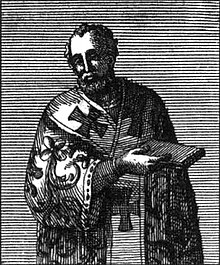Michael Rohoza
Mykhajlo Rohoza | |
|---|---|
| Metropolitan of Kiev | |
 | |
| Church | Ukrainian Church |
| Appointed | July 1589 |
| Term ended | 1599 |
| Predecessor | Onesiphorus Devochka |
| Successor | Ipatii Potii (UGCC) in 1600 Yov Boretsky (EP) in 1620 |
| Orders | |
| Consecration | August 1589 (Bishop) by Jeremias II |
| Personal details | |
| Born | about 1540 |
| Died | 1599 |
Michel Rohoza (Template:Lang-be, Template:Lang-uk) (died 1599) was the Ukrainian Metropolitan of Kiev, Galychyna and All-Rus' from 1588 to his death in 1599. In 1595 he signed the Union of Brest which moved the Ukrainian Church from the jurisdiction of the Patriarchate of Constantinople to the jurisdiction of the Pope, thus forming the Ukrainian Greek Catholic Church.
Life
He was born on about 1540 from a noble Belarusians family in the region of Volhynia. He probably studied in a Jesuit college in Vilnius where he worked as clerk for the prince Bogush Koretsky. He later entered in the monastery of the Ascension in Minsk of which he became archimandrite in 1579.
In 1589 Patriarch Jeremias II of Constantinople visited the Polish–Lithuanian Commonwealth on his return trip to Constantinople and, in agreement with king Sigismund III Vasa, deposed the Metropolitan Onesiphorus Devochka, probably because he was a digamy (the second marriage for priests) and he tolerated this use.[1] King Sigismund, under the advice of the local nobility, appointed Michel Rohoza as Metropolitan, who was consecrated bishop by Jeremias II in August 1589 in Vilnius.[2][3]
As appointed Metropolitan, he started the reform of the Church, mainly by means of synods as the one summoned in 1590. His targets were reforming the mores of the clergy and a reduction of the meddling of lay people (and of confraternities) in the life of the Church and on monasteries. His attempts of reform were anyway opposed particularly from the stauropegics and the impossibility to carry on the reforms was one of the reasons for looking to Rome.[4]
Since 1590 Metropolitan of Kiev, Rohoza subscribed with all bishops a document soliciting a union with Catholic Church, conditioning this union of faith that Byzantine rite, liturgical practices and canon law would be preserved. This will was formalized in document on 2 December 1594 and again in two petitions, one to the king and one to Pope Clement VIII, undersigned in Brest on 12 June 1595. The Union of Brest was formally proclaimed 8 October 1596 always in Brest. Even if Rohoza signed the union, he later tried to hinder its action, but without results.[5]
Rohoza died between June and August 1599. He was succeeded by the bishop of Volodymyr, Ipatii Potii, a fierce supporter of the union. Not all the Ukrainians supported the union, and twenty years later, in 1620 the Patriarch of Jerusalem re-established a Kievan Metropolia under his own jurisdiction, which first Metropolitan was Yov Boretsky, so duplicating the hierarchy.
Notes
- ^ Magocsi, Paul (1996). A history of Ukraine. Toronto Buffalo: University of Toronto Press. p. 164. ISBN 978-0-8020-7820-9.
- ^ "Rahoza, Mykhajlo". Encyclopedia of Ukraine. Vol. 4. Toronto Buffalo: University of Toronto Press. 1993. p. 308. ISBN 978-0-8020-3009-2.
- ^ Morini, Enrico (2007). Chiese e culture nell'Est europeo : prospettive di dialogo. Milano: Paoline. pp. 150–152. ISBN 978-88-315-3328-7.
- ^ T. Kempa, Metropolita Michał Rahoza a unia brzeska, "Klio", t. 2: 2002, s. 56–62
- ^ Herbermann, Charles, ed. (1913). . Catholic Encyclopedia. New York: Robert Appleton Company.
